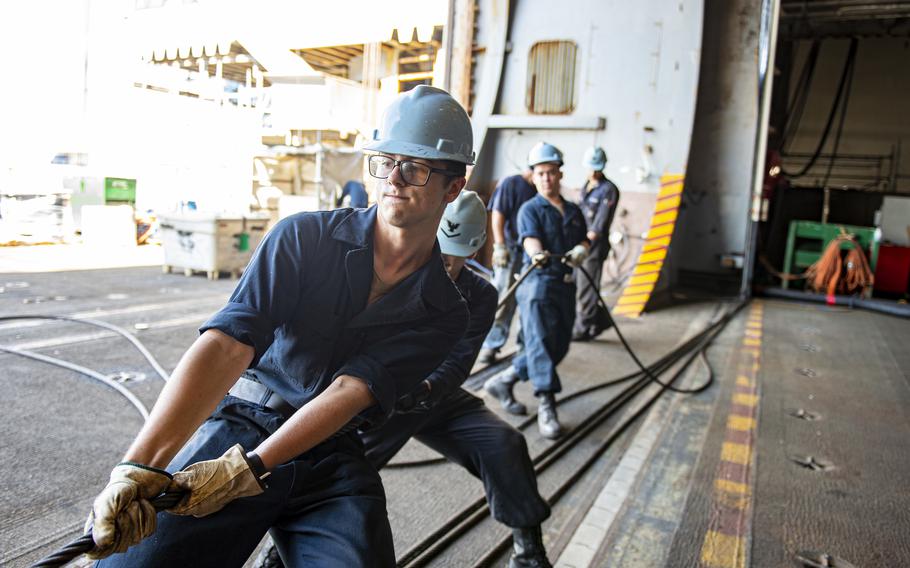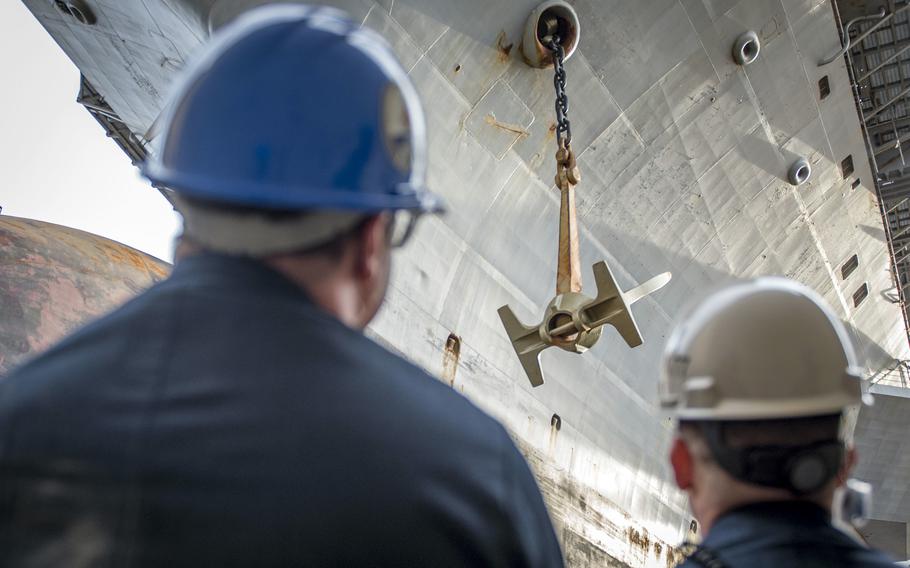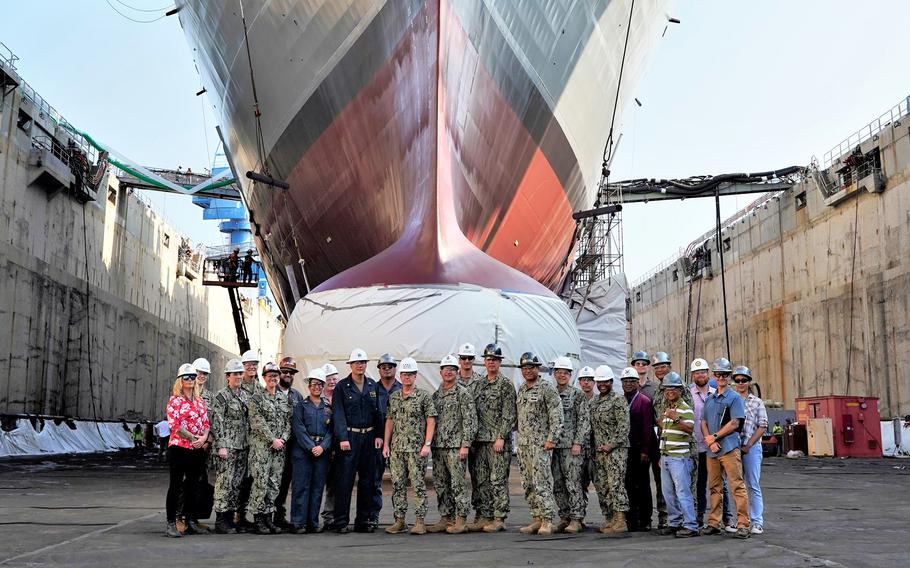
Crew members on the aircraft carrier USS Dwight D. Eisenhower hoist an elevator door cable during maintenance at the Norfolk Naval Shipyard, Va., Sept. 2, 2022. (Abbigail Beardsley/U.S. Navy)
The U.S. Navy, the bulwark in a potential armed conflict with China, suffers from failures in mission readiness that include maintenance backlogs, decaying shipyards and crew fatigue and shortages, the Government Accountability Office said in a report Tuesday.
The sea service’s readiness suffers to a greater degree than the other service branches, the report concluded.
The GAO assigned a “readiness rating” for the domains of air, sea, ground and space based on data from fiscal years 2017 through 2021. Only the sea rating decreased for both resource readiness and mission capability readiness during that period, according to the report.
Resource readiness ratings measure the status of personnel, equipment, supplies and training, while mission capability readiness ratings measure whether a unit can accomplish its designed missions, the report states.
Ground readiness increased in that pair of measurements, while air and space readiness had mixed ratings.
Backlogs and ‘cannibalizations’
The Navy was plagued by worsening ship maintenance backlogs over that five-year period for 10 classes of ships reviewed by the GAO.
“The 10 ship classes we reviewed face a litany of maintenance and supply challenges related to the age of the ship, shortages of trained maintenance personnel, and diminished manufacturing sources for parts, among others,” the report states.
“According to program officials, these challenges affect operational availability and the costs required to sustain those ships.”
The most troubled areas were increasing lengths of depot maintenance delays, more frequent “cannibalizations” of working parts for use elsewhere due to shortages, and reports of ships too impaired to conduct their primary missions.
“The average days of depot maintenance delay per ship among the 10 ship classes we examined increased about 5 days to about 19 days per ship in fiscal years 2011 through 2021,” the report states.
Officials from program offices for nine of the 10 ship classes told the GAO that they had a hard time getting needed spare parts, which resulted in an increase in ship maintainers reusing parts.
“With the exception of fiscal year 2017, the average number of cannibalizations per ship increased every year from 2015 to 2021,” the report states.

Sailors watch as the aircraft carrier USS George H.W. Bush's portside anchor is lowered into a dry dock for maintenance at Norfolk Naval Shipyard, Va., March 15, 2019. (Steven Edgar/U.S. Navy)
Shoddy shipyards
“The Navy in recent years has increasingly deferred maintenance on critical systems or canceled depot-level maintenance periods altogether for surface ships,” the report states.
At the GAO’s request, the Navy estimated a $1.8 billion cost to complete the existing deferred-maintenance backlog. The lion’s share of that, $1.7 billion, was for surface ships, with $100 million needed for aircraft carriers.
Dealing with maintenance delays and backlogs, according to the GAO, is hindered by the poor condition of the Navy’s four public shipyards: Norfolk Naval Shipyard in Virginia; Pearl Harbor Naval Shipyard and Intermediate Maintenance Facility in Hawaii; Portsmouth Naval Shipyard in Maine; and Puget Sound Naval Shipyard and Intermediate Maintenance Facility in Washington.
In 2018, the Navy undertook a $21 billion infrastructure plan to upgrade dry docks, buildings and equipment at the shipyards, and improvements were made, the report states.
However, the backlog of needed modernization projects on the shipyards has continued to grow, and more than half the capital equipment in the yards is past expected service life, according to the report.
The amount of funding needed to continue the modernization plan into the future is “well above” the levels estimated in recent years, the report states.

Adm. Samuel Paparo, commander of U.S. Pacific Fleet, poses Jan. 10, 2023, with sailors and personnel from Pearl Harbor Naval Shipyard and Intermediate Maintenance Facility, Hawaii, where the USS Michael Murphy is undergoing maintenance. (Marc Ayalin/U.S. Navy)
China vs. U.S. shipyards
In February, Navy Secretary Carlos Del Toro told reporters that China’s shipbuilding and repair capability far exceeds America’s, with the production capacity of its single largest yard greater than the U.S. Navy’s four yards combined.
Shipyard capacity would be vital “if there were to be a major shooting war with China,” Jan van Tol, a senior fellow at the Center for Strategic and Budgetary Assessments and a former Navy warship commander, told Stars and Stripes in a March 14 email.
“There would almost certainly be large losses of ships and aircraft (not to mention crews),” he wrote.
“That means that China would be able to replace lost assets and repair damaged ones that made it home at a far faster rate than we (and allies) could,” he wrote. “That has major implications for potential war outcomes. The state of the defense industrial base (both government and commercial) is unfortunately a ‘sleeper’ issue that few in or out of government know or care much about.”